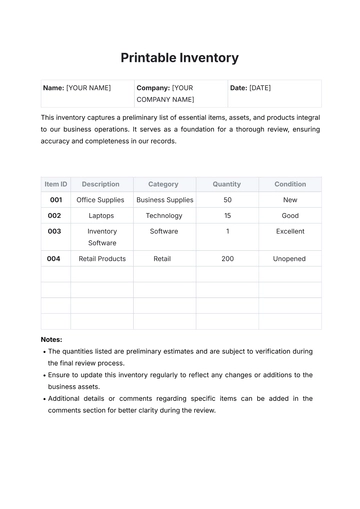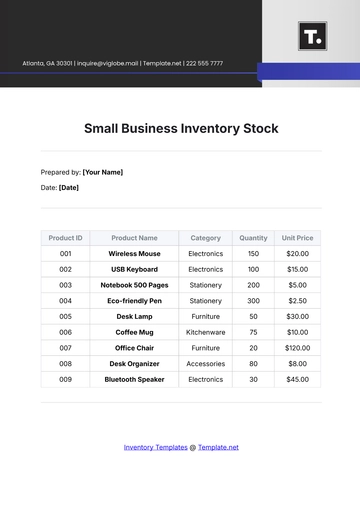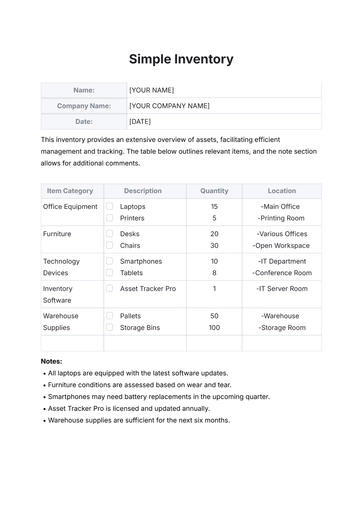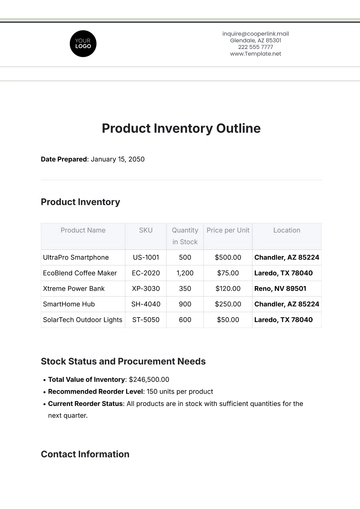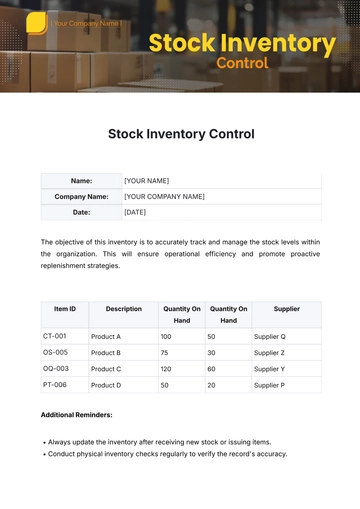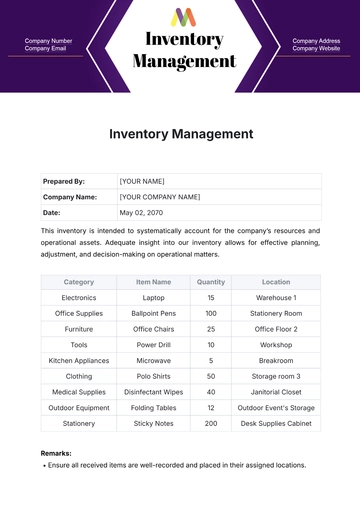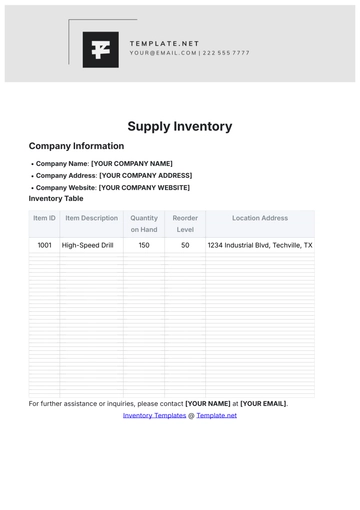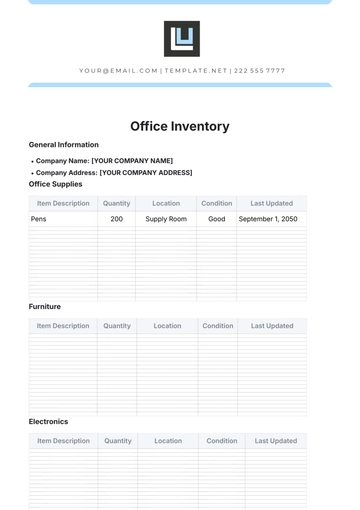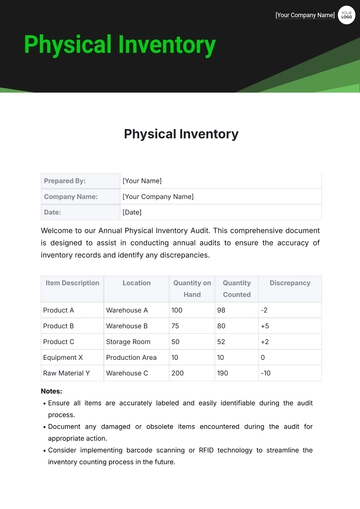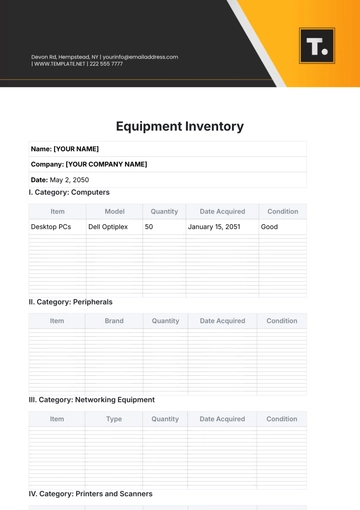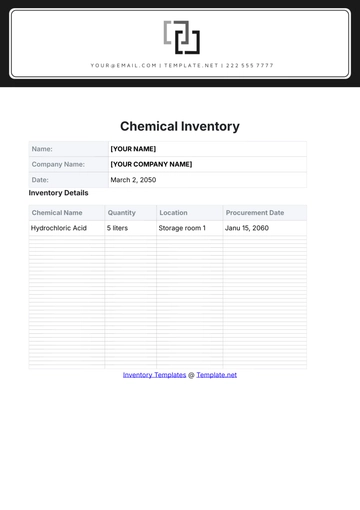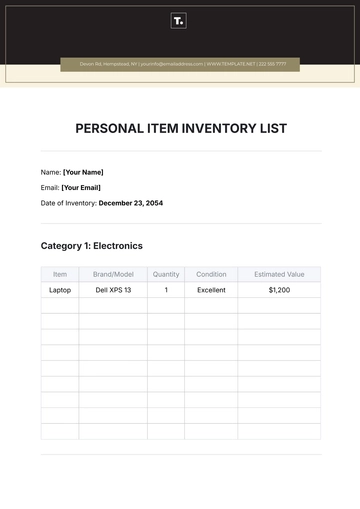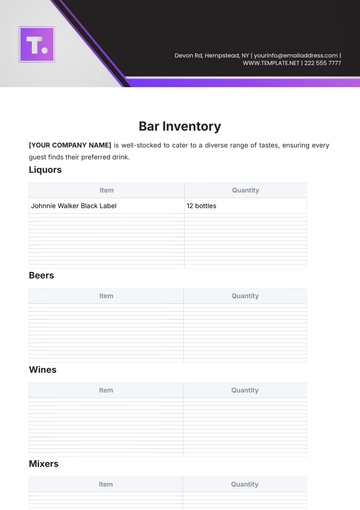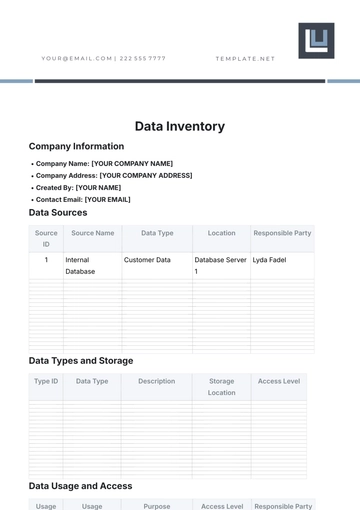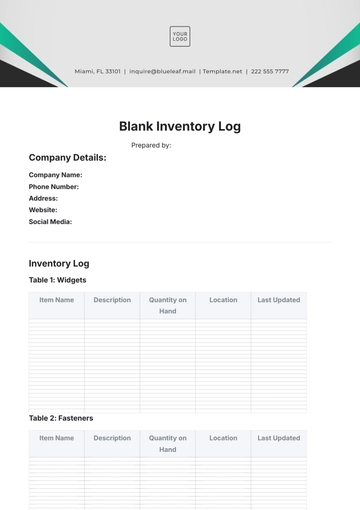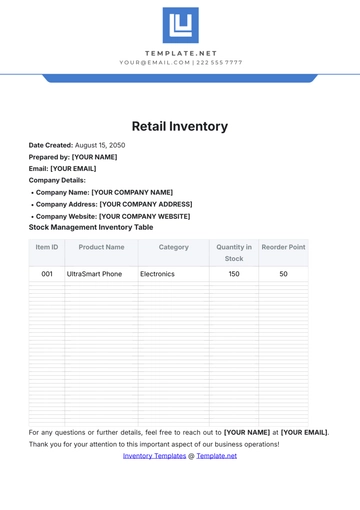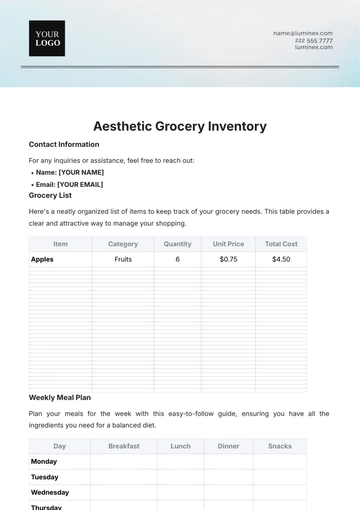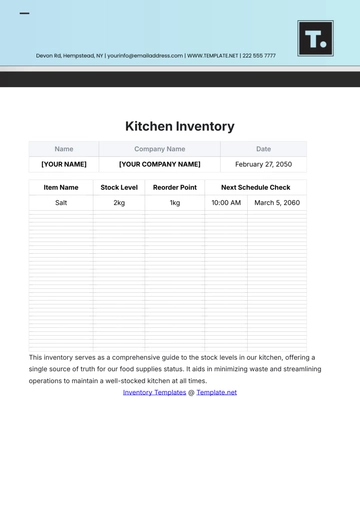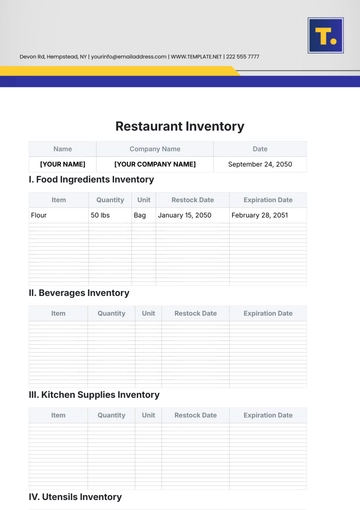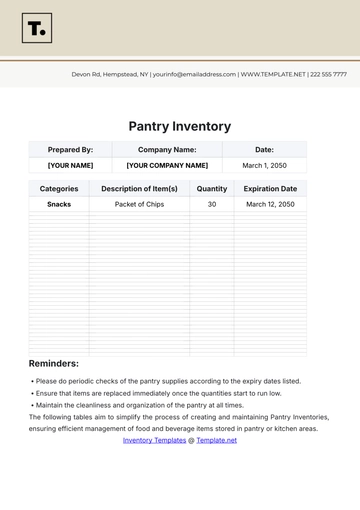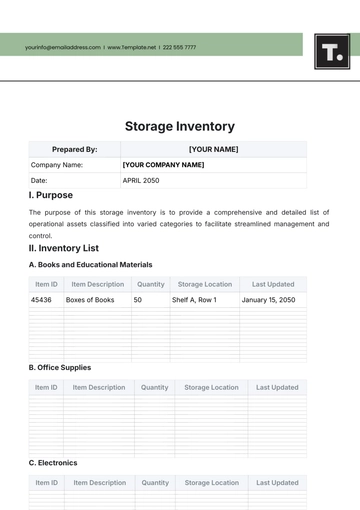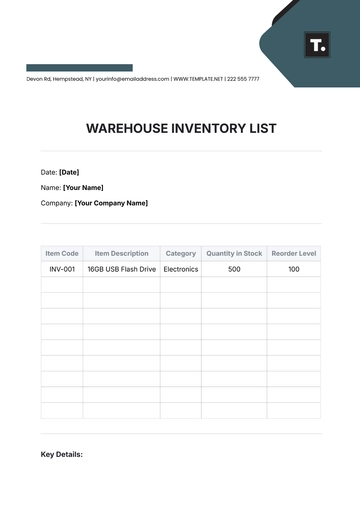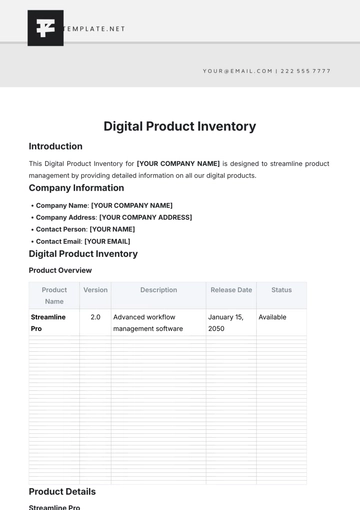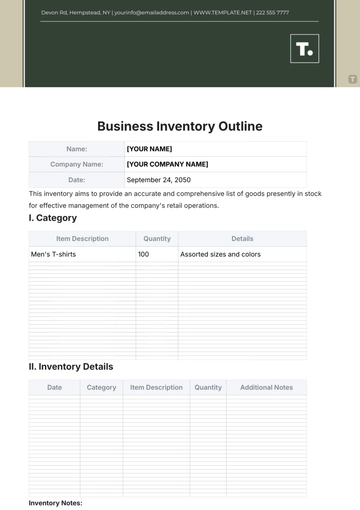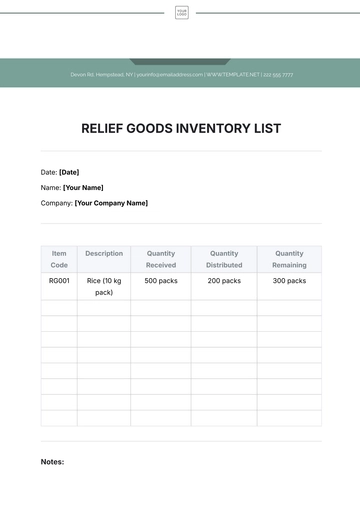Free Printable Movie Theater Inventory Report

I. Introduction
This Movie Theater Inventory Report provides a comprehensive overview of the inventory of [Your Company Name] for the year 2056. It includes details on current stock, inventory turnover rates, financial valuation, and future recommendations to improve inventory management.
A. Purpose of the Report
Overview: The primary purpose of this report is to present a detailed analysis of our inventory for the year 2056. This will help in understanding the current state of our inventory and identifying areas for improvement.
Evaluation: The report evaluates the inventory management practices currently in place. This evaluation will help in identifying strengths and weaknesses in our inventory management system.
Recommendations: Based on the analysis, the report will provide recommendations for improving inventory management. These recommendations aim to optimize our inventory processes and ensure efficient operations.
B. Methodology
Data Collection: The inventory data was collected from our centralized inventory management system. This data includes information on stock levels, turnover rates, and financial valuation.
Analysis: The data was analyzed using various inventory management metrics. This analysis helped in identifying trends and patterns in our inventory.
Reporting: The findings from the analysis were compiled into this report. This report provides a comprehensive overview of our inventory and includes detailed sections on key aspects of inventory management.
C. Scope of the Report
Time Period: The report covers inventory data for the year 2056. This time period was chosen to provide a comprehensive overview of our current inventory status.
Inventory Categories: The report includes an analysis of various inventory categories such as concessions, movie equipment, and office supplies. This categorization helps in understanding the inventory levels and turnover rates for different types of inventory.
Financial Valuation: The report includes a financial valuation of our inventory. This valuation helps in understanding the financial impact of our inventory and identifying areas for cost optimization.
II. Current Inventory Levels
A. Concessions Inventory
The following table provides an overview of our concessions inventory for the year 2056:
Item | Quantity | Unit Price | Total Value |
|---|---|---|---|
Popcorn | 10,000 | $2.50 | $25,000 |
Soda | 8,000 | $1.75 | $14,000 |
Candy | 5,000 | $1.50 | $7,500 |
Nachos | 2,500 | $3.00 | $7,500 |
Pretzels | 1,500 | $2.75 | $4,125 |
Popcorn: With a quantity of 10,000 units at a unit price of $2.50, the total value of our popcorn inventory is $25,000. Popcorn is one of our highest-selling items, and maintaining a high stock level ensures we meet customer demand.
Soda: Our soda inventory includes 8,000 units at a unit price of $1.75, totaling $14,000. Soda is a popular concession item, and our stock levels reflect the steady demand for this product.
Candy: We have 5,000 units of candy in stock, with a total value of $7,500. Candy offers a high margin, making it an important part of our concessions inventory.
Nachos: Our nacho inventory stands at 2,500 units, valued at $7,500. Nachos are a specialty item, and maintaining adequate stock levels is crucial to meeting customer preferences.
Pretzels: We have 1,500 units of pretzels, with a total value of $4,125. Pretzels add variety to our concessions menu and are popular among our customers.
Maintaining appropriate stock levels of our concessions items is essential for meeting customer demand and maximizing sales. Regular monitoring and replenishment of these items will ensure we provide a consistent and satisfying customer experience.
B. Movie Equipment Inventory
The following table provides an overview of our movie equipment inventory for the year 2056:
Item | Quantity | Unit Price | Total Value |
|---|---|---|---|
Projectors | 10 | $10,000 | $100,000 |
Screens | 8 | $5,000 | $40,000 |
Sound Systems | 6 | $8,000 | $48,000 |
Seating (per seat) | 500 | $100 | $50,000 |
Lighting Systems | 12 | $3,000 | $36,000 |
Projectors: We have 10 projectors in our inventory, each valued at $10,000, totaling $100,000. Projectors are critical for our operations, and having multiple units ensures we can continue screenings without interruptions.
Screens: Our inventory includes 8 screens, each valued at $5,000, with a total value of $40,000. Screens are essential for providing a high-quality viewing experience.
Sound Systems: We have 6 sound systems, each costing $8,000, totaling $48,000. High-quality sound systems enhance the movie-going experience and are a key component of our equipment inventory.
Seating: Our seating inventory includes 500 seats, each valued at $100, with a total value of $50,000. Comfortable seating is crucial for customer satisfaction.
Lighting Systems: We have 12 lighting systems in our inventory, each costing $3,000, totaling $36,000. Proper lighting is important for safety and ambiance in our theater.
Investing in high-quality movie equipment ensures we provide an exceptional movie-going experience. Regular maintenance and upgrades of these items will help maintain our competitive edge and customer satisfaction.
C. Office Supplies Inventory
The following table provides an overview of our office supplies inventory for the year 2056:
Item | Quantity | Unit Price | Total Value |
|---|---|---|---|
Computers | 15 | $1,000 | $15,000 |
Printers | 10 | $500 | $5,000 |
Office Chairs | 20 | $200 | $4,000 |
Desks | 15 | $300 | $4,500 |
Filing Cabinets | 10 | $250 | $2,500 |
Computers: We have 15 computers in our inventory, each valued at $1,000, totaling $15,000. Computers are essential for administrative tasks and efficient operations.
Printers: Our inventory includes 10 printers, each costing $500, with a total value of $5,000. Printers are necessary for printing tickets, reports, and other documents.
Office Chairs: We have 20 office chairs, each valued at $200, with a total value of $4,000. Comfortable office chairs contribute to a productive work environment.
Desks: Our desk inventory includes 15 units, each costing $300, totaling $4,500. Desks provide workspace for our staff and are essential for daily operations.
Filing Cabinets: We have 10 filing cabinets, each valued at $250, with a total value of $2,500. Filing cabinets are important for organizing and storing documents.
Proper management of office supplies ensures efficient administrative operations. Regular inventory checks and replenishments will help maintain productivity and organization in our office.
III. Inventory Turnover Rates
A. Concessions Inventory Turnover
The following table provides an overview of the inventory turnover rates for our concessions inventory in 2056:
Item | Sales | Average Inventory | Turnover Rate |
|---|---|---|---|
Popcorn | $75,000 | $25,000 | 3.0 |
Soda | $56,000 | $14,000 | 4.0 |
Candy | $30,000 | $7,500 | 4.0 |
Nachos | $22,500 | $7,500 | 3.0 |
Pretzels | $12,375 | $4,125 | 3.0 |
Popcorn: The inventory turnover rate for popcorn is 3.0, indicating that our popcorn stock is sold and replenished three times a year. This turnover rate suggests a steady demand for popcorn.
Soda: With a turnover rate of 4.0, our soda inventory is sold and replenished four times a year. This high turnover rate reflects the popularity of soda among our customers.
Candy: The turnover rate for candy is also 4.0, indicating that our candy stock is sold and replenished four times a year. Candy's high turnover rate highlights its popularity and profitability.
Nachos: Nachos have a turnover rate of 3.0, suggesting that our nacho stock is sold and replenished three times a year. This turnover rate indicates a stable demand for nachos.
Pretzels: The inventory turnover rate for pretzels is 3.0, indicating that our pretzel stock is sold and replenished three times a year. This turnover rate reflects a consistent demand for pretzels.
High inventory turnover rates for our concessions items indicate effective inventory management and strong customer demand. Maintaining these turnover rates will help maximize sales and minimize inventory costs.
B. Movie Equipment Inventory Turnover
The following table provides an overview of the inventory turnover rates for our movie equipment in 2056:
Item | Sales | Average Inventory | Turnover Rate |
|---|---|---|---|
Projectors | $50,000 | $100,000 | 0.5 |
Screens | $20,000 | $40,000 | 0.5 |
Sound Systems | $24,000 | $48,000 | 0.5 |
Seating | $25,000 | $50,000 | 0.5 |
Lighting Systems | $18,000 | $36,000 | 0.5 |
Projectors: The inventory turnover rate for projectors is 0.5, indicating that our projector stock is sold and replenished once every two years. This low turnover rate suggests the need for regular maintenance and potential upgrades.
Screens: With a turnover rate of 0.5, our screen inventory is sold and replenished once every two years. This rate reflects the durability and long-term usage of screens.
Sound Systems: The turnover rate for sound systems is 0.5, indicating that our sound system stock is sold and replenished once every two years. Regular maintenance is crucial to ensure high-quality sound.
Seating: Seating has a turnover rate of 0.5, suggesting that our seating inventory is sold and replenished once every two years. Maintaining comfortable seating is essential for customer satisfaction.
Lighting Systems: The inventory turnover rate for lighting systems is 0.5, indicating that our lighting stock is sold and replenished once every two years. Proper lighting maintenance enhances the theater ambiance.
Low inventory turnover rates for our movie equipment highlight the need for regular maintenance and upgrades to ensure optimal performance and customer satisfaction.
IV. Financial Valuation of Inventory
A. Total Inventory Value
The following chart and table provide the financial valuation of our total inventory for the year 2056:
Inventory Category | Total Value |
|---|---|
Concessions | $58,125 |
Movie Equipment | $274,000 |
Office Supplies | $31,000 |
Total Inventory Value | $363,125 |
Concessions: The total value of our concessions inventory is $58,125. This value represents a significant portion of our inventory and highlights the importance of effective concessions management.
Movie Equipment: Our movie equipment inventory is valued at $274,000. This high value reflects the critical role of equipment in delivering a quality movie-going experience.
Office Supplies: The total value of our office supplies inventory is $31,000. Proper management of office supplies ensures efficient administrative operations.
Total Inventory Value: The total value of our inventory is $363,125. This comprehensive valuation provides a clear picture of our inventory assets and their financial impact.
Accurate financial valuation of our inventory helps in understanding the financial impact and optimizing inventory management practices. Regular valuation and analysis will aid in effective decision-making.
B. Inventory Valuation Methods
The following table provides an overview of the inventory valuation methods used for our inventory in 2056:
Inventory Category | Valuation Method |
|---|---|
Concessions | FIFO (First-In, First-Out) |
Movie Equipment | Depreciation |
Office Supplies | LIFO (Last-In, First-Out) |
Concessions: We use the FIFO method for valuing our concessions inventory. This method ensures that the oldest stock is sold first, reducing the risk of spoilage and maintaining product freshness.
Movie Equipment: Depreciation is used for valuing our movie equipment inventory. This method accounts for the wear and tear of equipment over time, providing an accurate valuation.
Office Supplies: The LIFO method is used for valuing our office supplies inventory. This method ensures that the most recently acquired stock is used first, optimizing inventory turnover.
Using appropriate valuation methods for different inventory categories helps in maintaining accurate financial records and optimizing inventory management practices.
V. Inventory Control Practices
A. Concessions Inventory Control
Regular Stock Audits: Conduct regular stock audits to ensure accurate inventory records and identify discrepancies.
Inventory Replenishment: Implement an efficient inventory replenishment system to maintain optimal stock levels and prevent stockouts.
Expiry Management: Monitor the expiry dates of perishable items and implement FIFO to reduce wastage.
Storage Conditions: Ensure proper storage conditions for concessions items to maintain product quality and prevent spoilage.
Vendor Management: Maintain good relationships with vendors to ensure timely deliveries and favorable terms.
Effective concessions inventory control practices help in reducing wastage, maintaining product quality, and ensuring customer satisfaction.
B. Movie Equipment Inventory Control
Maintenance Schedules: Establish regular maintenance schedules for movie equipment to ensure optimal performance and extend the lifespan of the equipment.
Usage Tracking: Track the usage of movie equipment to identify wear and tear and plan for timely replacements.
Asset Tagging: Use asset tagging for movie equipment to maintain accurate inventory records and facilitate easy tracking.
Spare Parts Inventory: Maintain an inventory of spare parts to ensure quick repairs and minimize downtime.
Proper inventory control practices for movie equipment ensure uninterrupted operations and high-quality movie screenings.
C. Office Supplies Inventory Control
Reorder Levels: Set reorder levels for office supplies to ensure timely replenishment and prevent stockouts.
Usage Monitoring: Monitor the usage of office supplies to identify patterns and optimize stock levels.
Supplier Agreements: Establish agreements with suppliers for consistent supply and favorable pricing.
Inventory Software: Use inventory management software to track office supplies and maintain accurate records.
Effective control of office supplies inventory ensures smooth administrative operations and cost optimization.
VI. Inventory Management Challenges
A. Concessions Inventory Challenges
Spoilage: Managing the spoilage of perishable items is a significant challenge. Implementing proper storage and FIFO practices can help mitigate this issue.
Demand Forecasting: Accurately forecasting demand for concessions items is challenging. Using historical data and trends can improve forecasting accuracy.
Vendor Reliability: Ensuring reliable deliveries from vendors can be challenging. Establishing strong vendor relationships and having backup suppliers can mitigate this risk.
Stockouts: Preventing stockouts of popular concessions items requires effective inventory management practices.
Addressing these challenges will help improve the efficiency of our concessions inventory management.
B. Movie Equipment Inventory Challenges
Maintenance Costs: Managing the costs associated with regular maintenance of movie equipment is a challenge. Implementing preventive maintenance can help reduce these costs.
Technological Advancements: Keeping up with technological advancements in movie equipment is challenging. Regular upgrades and replacements are necessary to stay competitive.
Depreciation: Managing the depreciation of movie equipment and accurately valuing the inventory is a challenge. Using appropriate depreciation methods can provide accurate valuations.
Storage Space: Ensuring adequate storage space for movie equipment is challenging. Optimizing storage space and using efficient storage solutions can help mitigate this issue.
Addressing these challenges will help ensure the optimal performance of our movie equipment and enhance the movie-going experience.
C. Office Supplies Inventory Challenges
Usage Variability: Managing the variability in the usage of office supplies is challenging. Monitoring usage patterns can help optimize stock levels.
Supplier Reliability: Ensuring reliable supply of office supplies can be challenging. Establishing strong supplier relationships can mitigate this risk.
Cost Management: Managing the costs associated with office supplies is a challenge. Implementing cost-saving measures can help optimize expenses.
Inventory Tracking: Maintaining accurate records of office supplies inventory is challenging. Using inventory management software can improve tracking accuracy.
Addressing these challenges will help ensure efficient administrative operations and cost optimization.
VII. Inventory Management Systems
A. Current Systems
Inventory Software: We use inventory management software to track and manage our inventory. This software helps in maintaining accurate records and optimizing stock levels.
Barcode Scanning: Barcode scanning is used for inventory tracking and management. This technology helps in reducing errors and improving efficiency.
Automated Reordering: Automated reordering systems are used to replenish stock levels. This system ensures timely replenishment and prevents stockouts.
Vendor Management: We use vendor management systems to manage relationships with suppliers and ensure timely deliveries.
Our current inventory management systems help in maintaining accurate records, optimizing stock levels, and ensuring efficient operations.
B. Future Enhancements
AI Integration: Integrating AI into our inventory management systems can improve demand forecasting and inventory optimization.
IoT Sensors: Using IoT sensors for real-time inventory tracking can improve accuracy and efficiency.
Mobile Solutions: Implementing mobile solutions for inventory management can enhance accessibility and ease of use.
Advanced Analytics: Using advanced analytics for inventory management can provide deeper insights and improve decision-making.
Future enhancements to our inventory management systems will help improve efficiency, accuracy, and decision-making.
VIII. Recommendations
A. Concessions Inventory
Implement FIFO: Implement the FIFO method for all perishable items to reduce spoilage and maintain product freshness.
Regular Audits: Conduct regular stock audits to ensure accurate inventory records and identify discrepancies.
Demand Forecasting: Improve demand forecasting using historical data and trends to optimize stock levels.
Vendor Management: Establish strong relationships with vendors to ensure reliable deliveries and favorable terms.
Storage Conditions: Ensure proper storage conditions for all concessions items to maintain product quality and prevent spoilage.
B. Movie Equipment Inventory
Preventive Maintenance: Implement preventive maintenance schedules for all movie equipment to ensure optimal performance and extend the lifespan of the equipment.
Regular Upgrades: Plan for regular upgrades and replacements to keep up with technological advancements and maintain a competitive edge.
Accurate Valuation: Use appropriate depreciation methods to accurately value movie equipment inventory.
Optimize Storage: Optimize storage space for movie equipment using efficient storage solutions.
C. Office Supplies Inventory
Monitor Usage: Monitor the usage of office supplies to identify patterns and optimize stock levels.
Establish Supplier Agreements: Establish agreements with suppliers for consistent supply and favorable pricing.
Implement Cost-Saving Measures: Implement cost-saving measures to manage expenses associated with office supplies.
Use Inventory Software: Use inventory management software to track office supplies and maintain accurate records.
Implementing these recommendations will help improve our inventory management practices and ensure efficient operations.
IX. Conclusion
This Movie Theater Inventory Report of [Your Company Name] for the year 2056 presents a comprehensive overview of our current stock levels, turnover rates, and financial valuation. Effective management of our inventory is crucial for meeting customer demand, optimizing costs, and ensuring efficient operations. The recommendations provided in this report aim to improve our inventory management practices and enhance overall performance.
Regular monitoring, accurate valuation, and strategic planning are essential for maintaining optimal inventory levels and ensuring the success of our movie theater business. By implementing the proposed recommendations, we can achieve our inventory management goals and continue to provide an exceptional movie-going experience for our customers.
- 100% Customizable, free editor
- Access 1 Million+ Templates, photo’s & graphics
- Download or share as a template
- Click and replace photos, graphics, text, backgrounds
- Resize, crop, AI write & more
- Access advanced editor
Keep track of your inventory efficiently with the Printable Movie Theater Inventory Report Template! Available on Template.net, this editable template allows you to organize and report inventory details with ease. It is also customizable to suit your theater's inventory management needs. Use the AI Editor Tool to make modifications straightforward!
